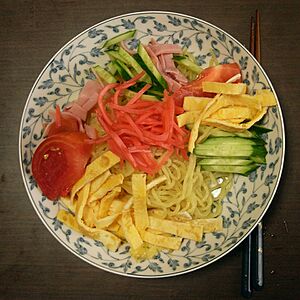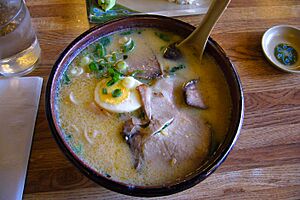Japanese Chinese cuisine facts for kids
Japanese Chinese cuisine, also called Chūka, is a popular style of food served in Chinese restaurants across Japan. This food became famous in Japan in the late 1800s and has continued to grow. It's a bit different from the "authentic" Chinese food you might find in places like Yokohama Chinatown. Many of these dishes came to Japan with Chinese immigrants, while others were brought back by Japanese soldiers who had been in China.
Contents
What is Chūka Cuisine?
Chūka (中華) is a Japanese word that means "Chinese food" but refers to dishes that have been changed to fit Japanese tastes. These dishes started in China but have been adapted over the years. Sometimes, Japanese ingredients or cooking styles are added, like in miso-ramen. Other times, only the noodles are Chinese, like in hiyashi chūka. This dish was invented in Sendai in 1937 and even uses Western ingredients like sliced ham! Since meat (other than fish) wasn't very common in Japanese cooking until recently, many meat dishes, especially pork dishes, have Chinese roots.
In the past, Chinese food was mostly found in Chinatowns in port cities like Kobe, Nagasaki, or Yokohama. Some of these dishes are even considered special foods of those cities. But now, Japanese-style Chinese food is available all over Japan. Japanese restaurants often specialize in just one type of dish. So, you'll find Chūka food mainly in three kinds of restaurants: Ramen restaurants, Dim sum houses, and regular Chinese-style restaurants.
Ramen: Japan's Favorite Noodles
Ramen (ラーメン) is a dish of noodles in a tasty broth, usually topped with meat and vegetables. It's sometimes called Chuka Soba (中華そば), which means "Chinese noodles." In Japan, ramen is one of the most popular fast-food choices. Almost every Japanese city has many affordable ramen restaurants. You can also find many types of instant ramen in stores, which are like a quick, easy meal.
Ramen originally came from the noodle soups of Cantonese cuisine, but it has changed a lot since then. There are four main types of ramen widely available in Japan:
The toppings used in ramen can change depending on the broth and the restaurant. Ramen restaurants often also serve Japanese-style fried rice and gyoza (pan-fried dumplings) as side dishes.
Dim Sum: Small Bites, Big Flavor
Dim sum (点心 tenshin or 飲茶 yamucha in Japanese) in Japan is often quite different from what you might find in Chinatowns in other countries. In Japan's Chinatown areas, some restaurants still bring many small dishes around on carts to your table. However, dim sum items have only recently become widely popular across Japan.
Instead of offering full menus of traditional Chinese items like stewed chicken's feet, Japanese dim sum restaurants, especially in big cities like Osaka and Tokyo, often have a cafe-like feel. At these cafes, the focus is often on tea and snacks rather than big meals. The menus usually feature items like Shumai (minced pork or shrimp dumplings) and sho lon po (steamed dumplings with juicy meat inside). These are usually served with pots of oolong or jasmine tea.
Popular Dishes in Japanese Chinese Restaurants

Chinese restaurants (中華料理屋 chūka ryōriya or 中華飯店 chūka hanten) in Japan serve a special set of popular dishes. These dishes are not always exactly like authentic Chinese food; they are often changed to suit Japanese tastes. Most towns in Japan now have at least one Chinese restaurant because this food is very popular. You can also buy many packaged sauces to easily cook your favorite Chinese-Japanese dishes at home.
Here are some typical dishes you might find:
- Mābō-dōfu (麻婆豆腐) is a stir-fried dish with ground pork and tofu cubes in a slightly spicy sauce.
- Mābō-nasu (麻婆茄子) is a stir-fried dish with ground pork and eggplant in a slightly spicy sauce. This dish became popular in Japan thanks to Chen Kenmin in 1952.
- Ebi no Chili Sauce (えびのチリソース) is a spicy shrimp dish with a thick sauce.
- Hoi Kō Rō (回鍋肉) is a stir-fry of thinly sliced pork and cabbage in a miso-based sauce with a touch of chili.
- Banbanji (棒棒鶏) is a cold dish of steamed chicken that is shredded and covered in a sesame sauce. It's often served with cold vegetables like carrot and cucumber as a salad.
- Chin-jao Rōsu (青椒肉絲) is a stir-fry of thinly sliced beef strips with Japanese green peppers and often bean sprouts in an oyster sauce.
- Champon (ちゃんぽん) is a ramen-like dish topped with fried pork, seafood, and vegetables.
- Subuta (酢豚) is the Japanese version of sweet and sour pork. It usually has a thicker, amber-colored sauce. Unlike the American version, it usually doesn't have pineapple. Sometimes, fried meatballs or chicken are used instead of pork.
- Chāshū (チャーシュー) comes from Chinese barbecued pork. However, the Japanese version is stewed in honey and soy sauce, giving it a light brown color, instead of being roasted and red.
- Shumai (焼売) is a type of traditional Chinese dumpling made with pork or glutinous rice.
- Chūkadon (中華丼) is a Cantonese-style stir-fry of vegetables and meat served on top of rice.
- Gyōza (餃子) are very popular in Japan. They are most often pan-fried, but can also be boiled or deep-fried. You'll find them in ramen shops and general Chūka restaurants.
- Kani-tama (かに玉) is similar to American Egg foo young, but it uses only crabmeat as the filling. It's served with a thick, brownish sauce.
- Chāhan (炒飯) is sometimes called "yakimeshi," meaning "fried rice." It's different from fried rice in other countries because it uses Japanese short-grain rice, which is stickier. The classic Japanese fried rice often uses egg, green peas, and thinly sliced ham, and usually doesn't use soy sauce, so it stays white.
- Shoronpo is the Japanese name for Xiao Long Bao (小籠包), which are steamed, juicy pork dumplings. They are very popular in Shanghai.
- Buta no Kakuni (豚の角煮) are thick slices of pork belly stewed in a soy sauce mixture. They are often served with Shanghai bok choi and Chinese mustard.
- Kara-age (唐揚) are bite-sized pieces of chicken thigh, dipped in a thick batter and fried. They are usually served without sauce, but some restaurants offer a salt and pepper mix for dipping.
- Yūrinchi (油淋鶏) is deep-fried chicken (like kara-age) topped with a sweet-and-sour sauce made from vinegar and soy sauce, plus chopped scallions. It's often served on shredded lettuce.
- Harumaki (春巻き) are very similar to spring rolls found in other Chinese restaurants, with a thin wrapper and vegetables inside.
- Nikuman (肉まん) or Chukaman (中華まん) is the Japanese name for Chinese baozi. These are steamed buns filled with cooked ground pork, beef, or other ingredients.
- Tenshindon (天津丼), also known as Tenshinhan (天津飯), is a dish of crab meat omelette (Kani-tama) served over rice. The dish is named after the port city of Tianjin in China.
See also
 In Spanish: Gastronomía sino-japonesa para niños
In Spanish: Gastronomía sino-japonesa para niños



